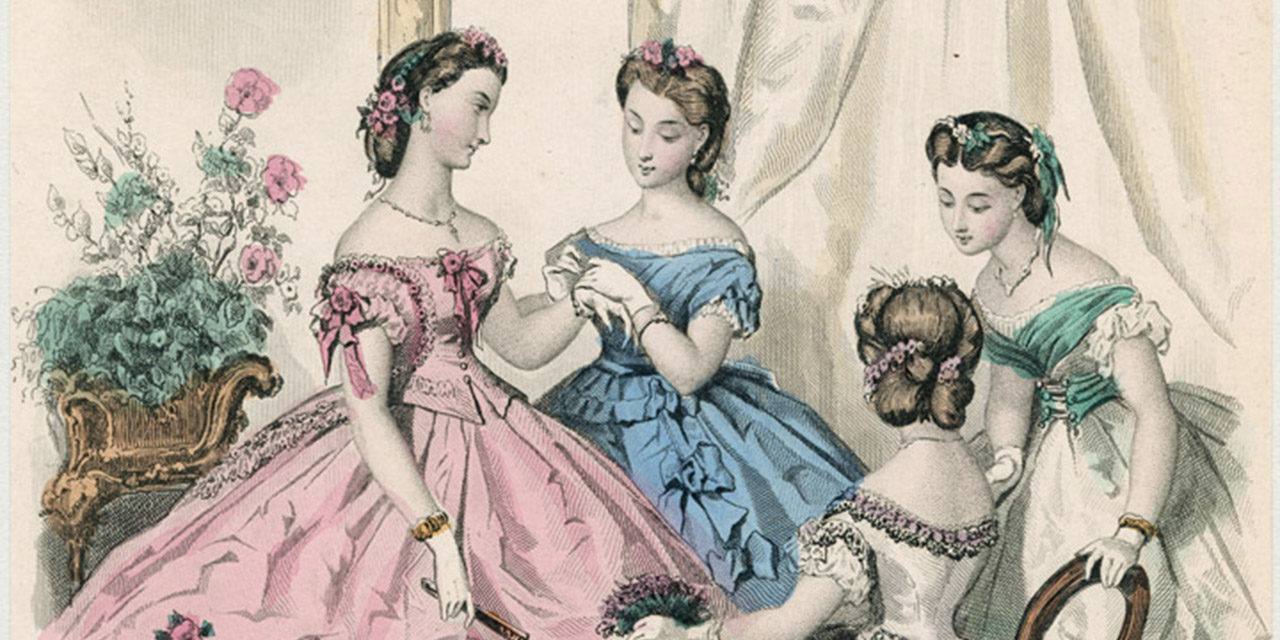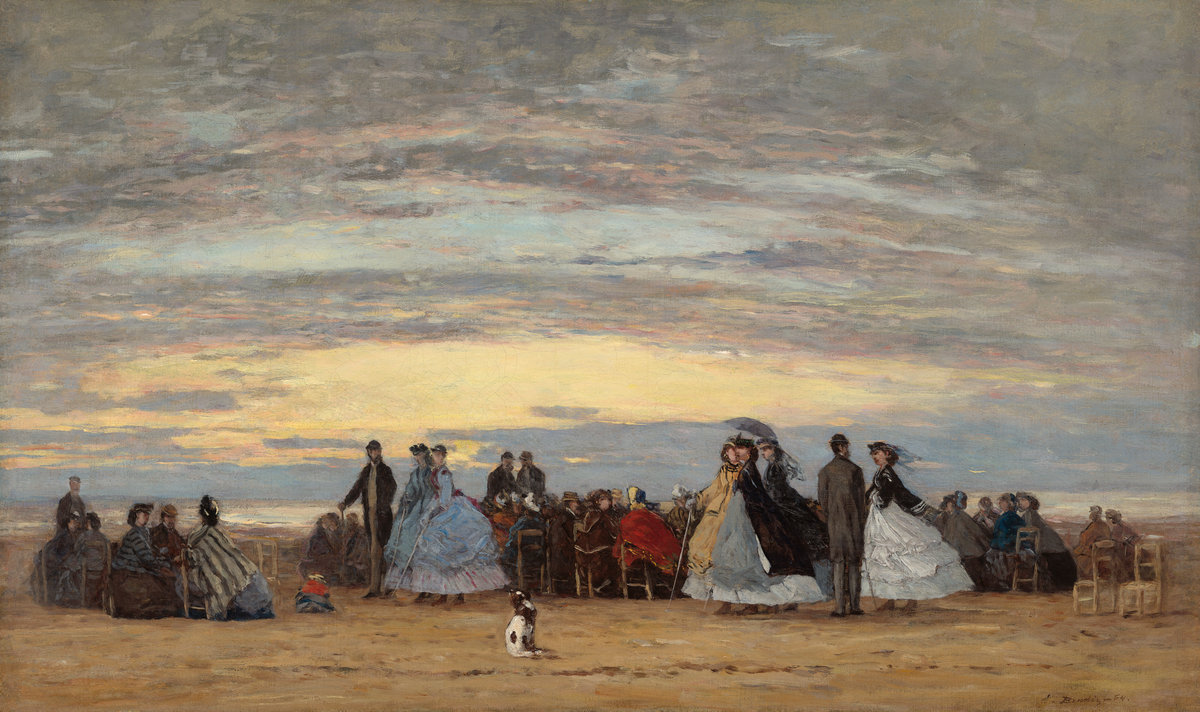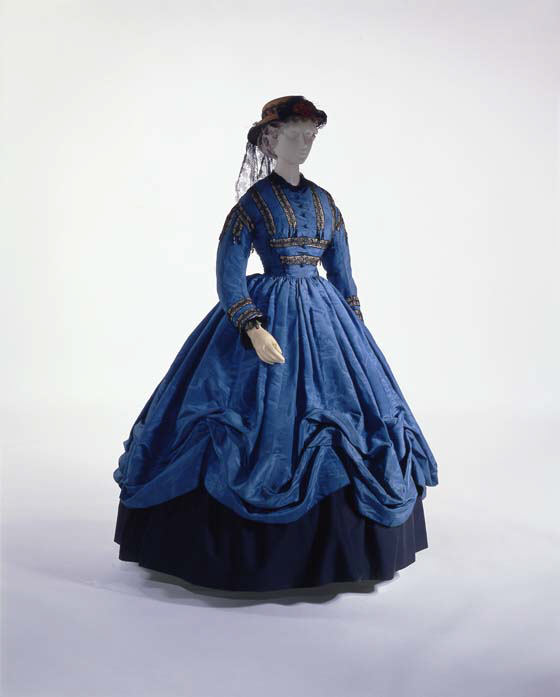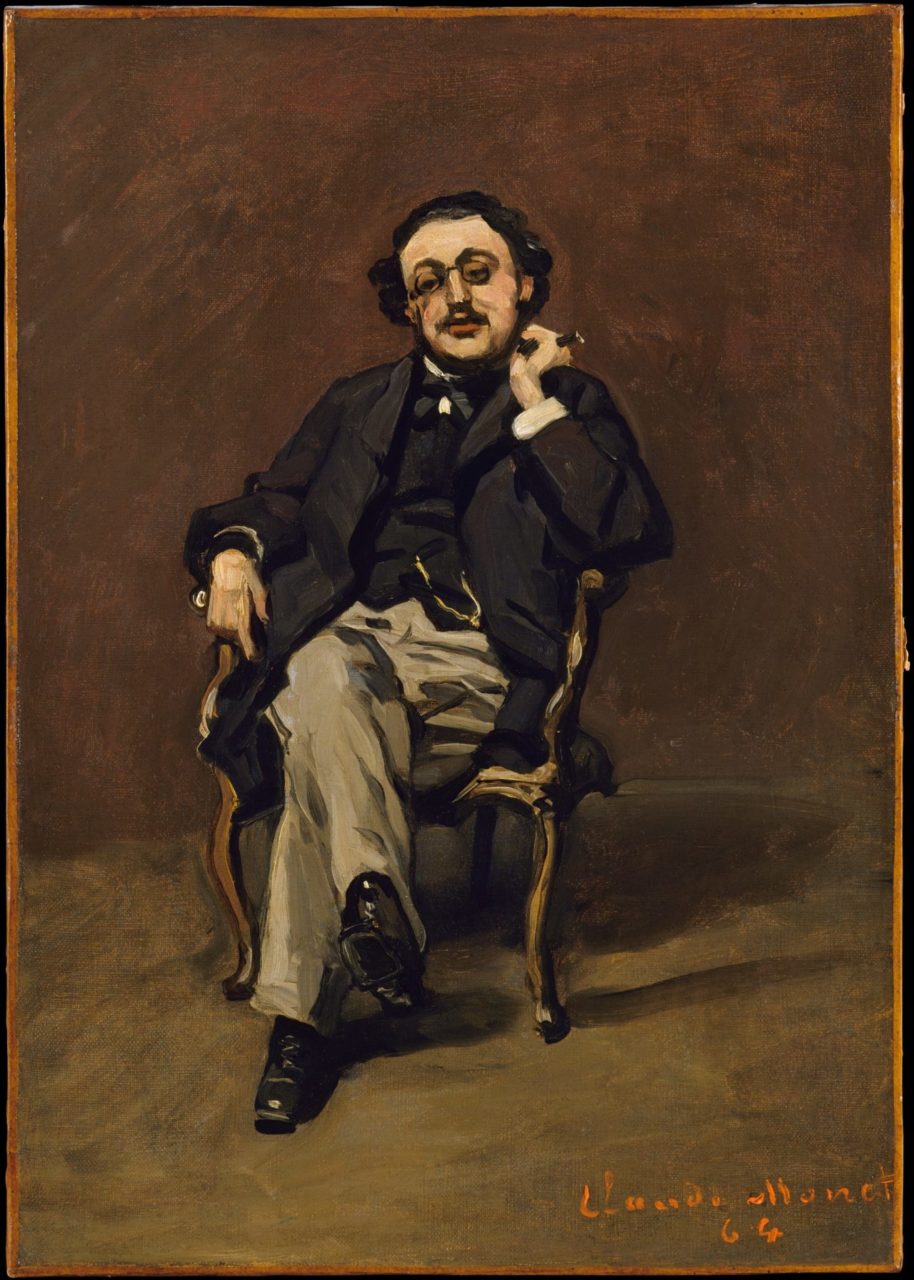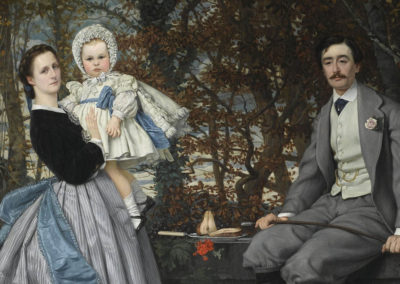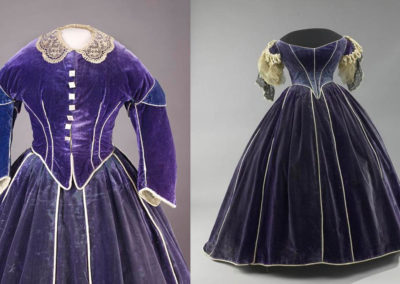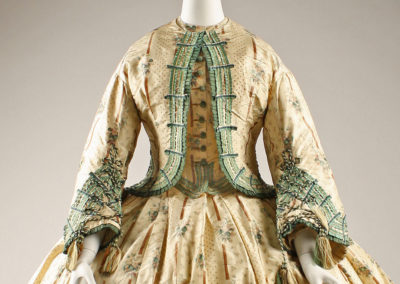OVERVIEW
1864 womenswear featured dresses adorned and trimmed lavishly with ruffles, bows, and lace, among many other luxurious fabrics.
Womenswear
In the fashion column of The Lady’s Friend, the editor speaks to the spirit of the clothing in 1864:
“Two years ago the fashions were borrowed from the taste of the eighteenth century, and particularly the Pompadour style, and now they are borrowed from the more scanty toilettes of Louis XVI reign.” (246)
This meant increased ornamentation, more obvious with evening wear, in the form of “trimmings (ruching, velvet appliqué, passementerie, lace)” which “seem to have taken up the slack where tiers and double skirts once reigned” (Rennolds Milbank 26). Another common trend for the evening are “the open wide neckline [that] was practically universal” (26). This can be seen on Emile Pingat’s ball gown (Fig. 1) where the neckline is so wide that it is nearly an off-the shoulder one. Though the black lace trimming at the hem of the skirt is simple, the intricacies of the gown lie elsewhere, such as on the bodice and on the ornamentation of the skirt that also includes fringe.
Though the volume of skirts was most definitely retained, it is more so in the back than evenly distributed all over, making it so that the front is a bit more flat.
Fig. 1 - Emile Pingat (French). Ball gown, 1864. Silk. New York: The Metropolitan Museum of Art, C.I.69.33.12a–c. Gift of Mary Pierrepont Beckwith, 1969. Source: The Metropolitan Museum of Art
Fig. 2 - Artist unknown. Le Follet, Tuesday, November 1, 1864. Los Angeles: Los Angeles Public Library. Source: Los Angeles Public Library
Fig. 3 - Artist unknown. Le Follet, Thursday, December 1, 1864. Los Angeles: Los Angeles Public Library. Source: Los Angeles Public Library
Fig. 4 - William Notman (Scottish-Canadian, 1826-1891). Mme George Webber, Montréal, QC, 1864, 1864. Photograph; 8 x 5 cm. Montreal: Musée McCord, I-13492.1. Purchase of Associated Screen News Ltd.. Source: Musée McCord
Fig. 5 - William Notman (Scottish-Canadian, 1826-1891). Mme De St. Ours, Montréal, QC, 1864, 1864. Photograph; 8.5 x 5.6 cm. Montreal: Musée McCord, I-10592.1. Purchase of Associated Screen News Ltd.. Source: Musée McCord
Dresses this year have a multitude of flowers, bows, lace, flounces, and frills (Figs. 2-3). Tassels are another popular trimming that adorn even the simplest of day dresses (Figs. 4-5) as captured by a number of photographs of women of respectable social status, but are nowhere near royalty, and also on fashion plates (Fig. 6).
In a May 1864 column of The Englishwoman’s Domestic Magazine, the editor speaks to the rise of passementerie (or heavy braid) as a form of ornamentation:
“Passementerie with jet was never more worn than now. It is placed upon everything. If an elegant and at the same time rich body is required, passementerie mixed with jet must not only be put round the edge of it, but round the pockets, and even the seams at the back. This trimming is rather heavy, but quite in fashion.” (304)
Fig. 6 - Artist unknown. Le Moniteur de la Mode, Sunday, May 1, 1864. Los Angeles: Los Angeles Public Library. Source: Los Angeles Public Library
Fig. 7 - Artist unknown. Englishwoman's Domestic Magazine, Tuesday, March 1, 1864. Los Angeles: Los Angeles Public Library. Source: Los Angeles Public Library
Fig. 8 - Artist unknown. Le Follet, Friday, January 1, 1864. Los Angeles: Los Angeles Public Library. Source: Los Angeles Public Library
This kind of trimming along with more simple rope braiding can be seen on many of the day dresses (Fig. 7) and cloaks illustrated in fashion plates and can be rendered more interesting with shapes like the zigzag edge highlighted by the trim on the black cloak (Fig. 8). The fashionable crinolined silhouette popular in 1864 is very evident in the beach scene depicted by Eugène Boudin (Fig. 9). A few of the dresses show the trend of raising the overskirt with a hidden system of cords to reveal a complementary underskirt, as does a surviving dress in the Met’s collection (Fig. 10).
Fig. 9 - Eugène Boudin (French, 1824 - 1898). The Beach at Villerville, 1864. Oil on canvas; 45.7 x 76.3 cm. Washington, D.C.: National Gallery of Art, 1963.10.4. Source: National Gallery of Art
Fig. 10 - Designer unknown (French). Dress, 1864. Silk. New York: The Metropolitan Museum of Art, C.I.40.183.2. Gift of Mrs. Dorothy H. Johnston, 1940. Source: The Metropolitan Museum of Art
Fig. 11 - James Tissot (French, 1836-1902). Portrait of Miss L. L., February 1864. Oil on canvas; 124 x 99.5 cm. Paris: Musée d'Orsay, RF 2698. Source: Musée d'Orsay
Women could also be extremely fashionable in their clothing without being excessive, as evidenced by James Tissot’s Portrait of Miss L. L. (Fig. 11). Though her ensemble is simple, the vibrant punch of color of her bolero, a garment gaining popularity at the time, combined with its playful pompoms make it so she is an undeniably well-dressed woman (De Young 234).
The Englishwoman’s Domestic Magazine further describes the appropriate trimmings of 1864, particularly bows:
“Another style of trimming very much approved of is that of a bow or rosette upon each breadth of the skirt from which depend three long ends fixed to it. The bows may be either in ribbon or velvet, the ends more or less long.” (119)
It is clear from Franz Xaver Winterhalter’s Portrait of Princess Sophia Radzivil (Fig. 12) that this trend extends to different areas of Europe as well, such as Germany. In addition to the ruffled ribbon trimmings at the neckline of the gown, there are also numerous dusty lilac ribbon bows with lengthy ends that adorn the center front of the bodice and the skirt. The pointed bodice and the fact that more of the skirt’s fullness is directed towards the back of the gown make it clear that the Princess is dressed in the most current fashions of her time.
Fig. 12 - Franz Xaver Winterhalter (German, 1805-1873). Portrait of Princess Sophia Radzivil, 1864. Oil on canvas; 126 x 94 cm. Saint Petersburg: Hermitage Museum. Source: Wikiart
Menswear
[To come…]
Fig. 1 - S. A.. Men In Suits, And Woman In Ballgown, 1860s, 1864. Drawing; 18 x 11 cm. New York: The New York Public Library Digital Collections. Source: The New York Public Library Digital Collections
Fig. 2 - Claude Monet (French, 1840–1926). Dr. Leclenché, 1864. Oil on canvas; 45.7 x 32.4 cm. New York: The Metropolitan Museum of Art, 51.32. Gift of Mr. and Mrs. Edwin C. Vogel, 1951. Source: The Metropolitan Museum of Art
Fig. 3 - William Notman (Scottish-Canadian, 1826-1891). Andrew A. MacDonald, politicien, Montréal, QC, 1864, 1864. Photograph; 8 x 5 cm. Montreal: Musée McCord, I-13484.1. Source: Musée McCord
Fig. 4 - William Notman (Scottish-Canadian, 1826-1891). Colonel John Hamilton Gray, Montréal, QC, 1864, 1864. Photograph; 12 x 10 cm. Montreal: Musée McCord, I-13482. Source: Musée McCord
Fig. 5 - Designer unknown (American). Suit, 1864. Wool, silk, leather, and cotton. New York: The Metropolitan Museum of Art, 1979.475.1a–f. Purchase, Friends of The Costume Institute Gifts, 1979. Source: The Metropolitan Museum of Art
CHILDREN’S WEAR
Fig. 1 - Artist unknown. Magasin des Demoiselles, Friday, April 1, 1864. Los Angeles: Los Angeles Public Library. Source: Los Angeles Public Library
Fig. 2 - Designer unknown (American). Dress, 1864. Cotton. New York: The Metropolitan Museum of Art, C.I.64.61.2. Gift of Mrs. Frank O. Bowman, 1964. Source: The Metropolitan Museum of Art
Fig. 3 - Designer unknown (American). Undershirt, 1864. Linen. New York: The Metropolitan Museum of Art, 2009.300.3008. Brooklyn Museum Costume Collection at The Metropolitan Museum of Art, Gift of the Brooklyn Museum, 2009; Gift of Louise G. Zabriskie, 1932. Source: The Metropolitan Museum of Art
Fig. 4 - Artist unknown. Girl's Coat, Front And Back, 1860s, 1864. Drawing; 22 x 13 cm (drawing). New York: The New York Public Library Digital Collections. Source: The New York Public Library Digital Collections
Fig. 5 - Artist unknown. Children's Fashions for August, August 1864. Fashion plate; 14 x 22 cm. New York: The New York Public Library Digital Collections. Source: The New York Public Library Digital Collections
References:
- De Young, Justine. “Fashion and the Press.” In Impressionism, Fashion & Modernity, edited by Gloria Groom, 233–43. New Haven: Yale University Press, 2012. http://www.worldcat.org/oclc/878842920.
- “Fashions.” The Lady’s Friend 1 (March 1864): 246. https://babel.hathitrust.org/cgi/pt?id=umn.31951000753433o;view=1up;seq=262.
- “La Mode.” The Englishwoman’s Domestic Magazine 10, no. 49 (May 1864): 304. https://babel.hathitrust.org/cgi/pt?id=uc1.c0000044222;view=1up;seq=25;size=200.
- “La Mode.” The Englishwoman’s Domestic Magazine 10, no. 64 (August 1864): 119. https://babel.hathitrust.org/cgi/pt?id=uc1.c0000044222;view=1up;seq=231;size=175.
- Millbank, Caroline Rennolds. Fashion: A Timeline in Photographs: 1850 to Today. New York: Rizzoli International Publications, Inc., 2015. http://www.worldcat.org/oclc/938800542.
- Tétart-Vittu, Françoise, and Gloria Groom. “Key Dates in Fashion and Commerce, 1851-89.” In Impressionism, Fashion, & Modernity, ed. Gloria Groom, 270-79. New Haven: Yale University Press, 2012. http://www.worldcat.org/oclc/878842920.
- “The United States and Canada, 1800–1900 A.D. | Chronology.” The Met’s Heilbrunn Timeline of Art History. Accessed April 15, 2018. https://www.metmuseum.org/toah/ht/10/na.html.
Historical Context
Wikipedia: 1864
Rulers:
- America
- President Abraham Lincoln (1861-65)
- England: Queen Victoria (1837-1901)
- France: Emperor Napoleon III (1852-70)
- Spain
- Queen Isabella II (1833-68)
Europe 1867. Source: Omniatlas
Events:
- 1861-65 – American Civil War
- “The United States Civil War, a military conflict between the Union and the Confederacy, begins in April 1861 when Charleston’s Fort Sumter is fired upon. The conflict lasts four years, takes more than 600,000 lives, and emancipates 4 million enslaved people.” (The MET)
- “Charles Frederick Worth is listed in the directory of commerce as an official purveyor to Empress Eugénie.” (Tétart-Vittu 273)
- October 31: “Nevada is admitted as the 36th U.S. state.”
- November 8: “Abraham Lincoln is reelected, in an overwhelming victory over George B. McClellan.”
Primary/Period Sources
Resources for Fashion History Research
To discover primary/period sources, explore the categories below.
Have a primary source to suggest? Or a newly digitized periodical/book to announce? Contact us!
Fashion Plate Collections (Digitized)
- Costume Institute Fashion Plate collection
- Casey Fashion Plates (LA Public Library) - search for the year that interests you
- New York Public Library:
NYC-Area Special Collections of Fashion Periodicals/Plates
- FIT Special Collections (to make an appointment, click here)
- Englishwoman's Domestic Magazine (London: 1852-79), 1860-64, 1867-69 (TT500 .E6)
- Costume Institute/Watson Library @ the Met (register here)
- New York Public Library
- Brooklyn Museum Library (email for access)
Womenswear Periodicals (Digitized)
Etiquette Books (Digitized)
Menswear Periodicals (Digitized)
Secondary Sources
Also see the 19th-century overview page for more research sources... or browse our Zotero library.

